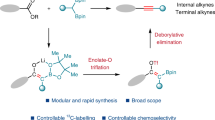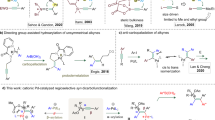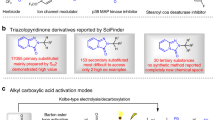Abstract
Hindered ethers are of high value for various applications; however, they remain an underexplored area of chemical space because they are difficult to synthesize via conventional reactions1,2. Such motifs are highly coveted in medicinal chemistry, because extensive substitution about the ether bond prevents unwanted metabolic processes that can lead to rapid degradation in vivo. Here we report a simple route towards the synthesis of hindered ethers, in which electrochemical oxidation is used to liberate high-energy carbocations from simple carboxylic acids. These reactive carbocation intermediates, which are generated with low electrochemical potentials, capture an alcohol donor under non-acidic conditions; this enables the formation of a range of ethers (more than 80 have been prepared here) that would otherwise be difficult to access. The carbocations can also be intercepted by simple nucleophiles, leading to the formation of hindered alcohols and even alkyl fluorides. This method was evaluated for its ability to circumvent the synthetic bottlenecks encountered in the preparation of 12 chemical scaffolds, leading to higher yields of the required products, in addition to substantial reductions in the number of steps and the amount of labour required to prepare them. The use of molecular probes and the results of kinetic studies support the proposed mechanism and the role of additives under the conditions examined. The reaction manifold that we report here demonstrates the power of electrochemistry to access highly reactive intermediates under mild conditions and, in turn, the substantial improvements in efficiency that can be achieved with these otherwise-inaccessible intermediates.
This is a preview of subscription content, access via your institution
Access options
Access Nature and 54 other Nature Portfolio journals
Get Nature+, our best-value online-access subscription
$29.99 / 30 days
cancel any time
Subscribe to this journal
Receive 51 print issues and online access
$199.00 per year
only $3.90 per issue
Buy this article
- Purchase on SpringerLink
- Instant access to full article PDF
Prices may be subject to local taxes which are calculated during checkout



Similar content being viewed by others
Data availability
The data that support the findings of this study are available within the paper and its Supplementary Information. Metrical parameters for the structures of (2R)-77 and (11R)-138 are available free of charge from the Cambridge Crystallographic Data Centre (https://www.ccdc.cam.ac.uk/) under reference numbers 1918528 and 1903823, respectively.
References
Roughley, S. D. & Jordan, A. M. The medicinal chemist’s toolbox: an analysis of reactions used in the pursuit of drug candidates. J. Med. Chem. 54, 3451–3479 (2011).
Fischer, J. & Ganellin, C. R. (eds) Analogue-based Drug Discovery 206–217 (Wiley, 2006).
Williamson, W. Ueber die theorie der aetherbildung. Justus Liebigs Ann. Chem. 77, 37–49 (1851).
Kürti, L. & Czakó, B. Strategic Applications of Named Reactions in Organic Synthesis 484–485 (Elsevier, 2005).
Swamy, K. C. K., Kumar, N. N. B., Balaraman, E. & Kumar, K. V. P. P. Mitsunobu and related reactions: advances and applications. Chem. Rev. 109, 2551–2651 (2009).
Beyerman, H. C. & Heiszwolf, G. J. Reaction of steroidal alcohols with isobutene. Usefulness of t-butyl as a hydroxyl-protecting group in a synthesis of testosterone. Recl. Trav. Chim. Pays-Bas 84, 203–212 (1965).
Smith, M. B. & March, J. March’s Advanced Organic Chemistry 1037–1041 (Wiley, 2007).
Abraham S. et al. Aurora kinase compounds and methods of their use. International patent no. WO2011088045A1 (2011).
Kolbe, H. Beobachtungen über die oxydirende wirkung des sauerstoffs, wenn derselbe mit hülfe einer elektrischen säule entwickelt wird. J. Prakt. Chem. 41, 137–139 (1847).
Hofer, H. & Moest, M. Mittheilung aus dem elektrochemischen Laboratorium der Königl, Technischen Hochschule zu München. Justus Liebigs Ann. Chem. 323, 284–323 (1902).
Corey, E. J., Bauld, N. L., La Londe, R. T., Casanova, J., Jr & Kaiser, E. T. Generation of cationic carbon by anodic oxidation of carboxylic acids. J. Am. Chem. Soc. 82, 2645–2646 (1960).
Luo, X., Ma, X., Lebreux, F., Markó, I. E. & Lam, K. Electrochemical methoxymethylation of alcohols – a new, green and safe approach for the preparation of MOM ethers and other acetals. Chem. Commun. 54, 9969–9972 (2018).
Bunyan, P. J. & Hey, D. H. The electrolysis of some aryl-substituted, aliphatic acids. J. Chem. Soc. 1360–1365 (1962).
Iwasaki, T., Hrorikawa, H., Matsumoto, K. & Miyoshi, M. Electrochemical synthesis and reactivity of α-alkoxy α-amino acid derivatives. Bull. Chem. Soc. Jpn. 52, 826–830 (1979).
Tajima, T., Kurihara, H. & Fuchigami, T. Development of an electrolytic system for non-Kolbe electrolysis based on the acid−base reaction between carboxylic acids as a substrate and solid-supported bases. J. Am. Chem. Soc. 129, 6680–6681 (2007).
Shtelman, A. V. & Becker, J. Y. Electrochemical synthesis of 1,2-disilylethanes from α-silylacetic acids. J. Org. Chem. 76, 4710–4714 (2011).
Torii, S., Inokuchi, T., Mizuguchi, K. & Yamazaki, M. Electrolytic decarboxylation reactions. 4. Electrosyntheses of 3-alkyl-2-cycloalken-1-ol acetates from 1-alkyl-2-cycloalkene-1-carboxylic acids. Preparation of dl-muscone from cyclopentadecanone. J. Org. Chem. 44, 2303–2307 (1979).
Coleman, J. P., Lines, R., Utley, J. H. P. & Weedon, B. C. L. Electro-organic reactions. Part II. Mechanism of the kolbe electrolysis of substituted phenylacetate ions. J. Chem. Soc., Perkin Trans. 2 1064–1069 (1974).
Mao, R., Balon, J. & Hu, X. Decarboxylative C(sp3)–O cross-coupling. Angew. Chem. Int. Ed. 57, 13624–13628 (2018).
Yan, M., Kawamata, Y. & Baran, P. S. Synthetic organic electrochemical methods since 2000: on the verge of a renaissance. Chem. Rev. 117, 13230–13319 (2017).
Ross, S. D. & Finkelstein, M. Anodic oxidations. V. The Kolbe oxidation of phenylacetic acid and 1-methylcyclohexaneacetic acid at platinum and at carbon. J. Org. Chem. 34, 2923–2927 (1969).
Schäfer, H. J. Recent contributions of Kolbe electrolysis to organic synthesis. Top. Curr. Chem. 152, 91–151 (1990).
Koehl, W. J. Anodic oxidation of aliphatic acids at carbon anodes. J. Am. Chem. Soc. 86, 4686–4690 (1964).
Iwasaki, T., Horikawa, H., Matsumoto, K. & Miyoshi, M. An electrochemical synthesis of 2-acetoxy-2-amino acid and 3-acetoxy-3-amino acid derivatives. J. Org. Chem. 42, 2419–2423 (1977).
Huang, X., Liu, W., Hooker, J. M. & Groves, J. T. Targeted fluorination with the fluoride ion by manganese-catalyzed decarboxylation. Angew. Chem. Int. Ed. 54, 5241–5245 (2015).
Eberson, L. & Nyberg, K. Studies on the Kolbe electrolytic synthesis. V. An electrochemical analogue of the Ritter reaction. Acta Chem. Scand. 18, 1567–1568 (1964).
Acknowledgements
Financial support for this work was provided by Pfizer, Inc., the National Science Foundation (CCI Phase 1 grant 1740656), and the National Institutes of Health (grant number GM-118176). China Scholarship Council and Jilin University supported a fellowship to J.X., Zhejiang Yuanhong Medicine Technology Co. Ltd supported a fellowship to M.S., The Hewitt Foundation supported a fellowship to Y.K., The Swedish Research Council supported a fellowship to H.L., Fulbright Fellowship supported a fellowship to P.M., and S.H.R. acknowledges an NSF Graduate Research Fellowship Program (no. 2017237151) and a Donald and Delia Baxter Fellowship. We thank D.-H. Huang and L. Pasternack for assistance with NMR spectroscopy; J. Chen for measuring the high-resolution mass spectroscopy data, and A. Rheingold, C. E. Moore and M. A. Galella for X-ray crystallographic analysis.
Author information
Authors and Affiliations
Contributions
J.X., M.S. and P.S.B. conceived the project. J.X., M.S., Y.K., H.L., D.G.B. and P.S.B. designed the experiments and analysed the data. J.X. and M.S. developed the electrochemical decarboxylative methods and performed their applications. H.L. and Y.K. carried out the mechanistic study. J.X., M.S., S.H.R., M.C., P.M., G.B., M.R.C., A.D., M.D.B., G.M.G., J.E.S., J.S. and S.Y. conducted experiments to demonstrate the substrate scope. P.S.B. wrote the manuscript. J.X., M.S., Y.K., S.H.R., P.M., H.L. and D.G.B. assisted in writing and editing the manuscript.
Corresponding author
Ethics declarations
Competing interests
The authors declare no competing interests.
Additional information
Publisher’s note: Springer Nature remains neutral with regard to jurisdictional claims in published maps and institutional affiliations.
Supplementary information
Supplementary Data 1
Cif file of (2R)-77
Supplementary Data 2
Cif file of (11R)-138
Supplementary Data 3
Checkcif of (2R)-77
Supplementary Data 4
Checkcif of (11R)-138
Rights and permissions
About this article
Cite this article
Xiang, J., Shang, M., Kawamata, Y. et al. Hindered dialkyl ether synthesis with electrogenerated carbocations. Nature 573, 398–402 (2019). https://doi.org/10.1038/s41586-019-1539-y
Received:
Accepted:
Published:
Issue Date:
DOI: https://doi.org/10.1038/s41586-019-1539-y



